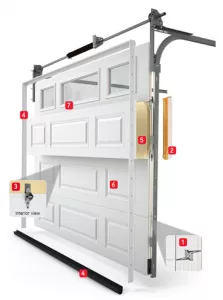
Do a quick comparison of multiple insulated garage doors, and you likely won’t notice much of a difference in the specs. But just because the R-values (also called RSI, the measurement of how insulated a door is) are basically the same does not mean that the doors will affect your energy bill the same. If a door doesn’t have a few key features, like effective thermal breaks and top‑performing weatherseals, there’s a very good chance that it is not saving you money on your energy bill.
Whether you are in the market for a new garage door, or you want to seriously cut down on your energy bills this year, there are a few things to know about shopping for this key home feature.
If you want to get the biggest reduction in energy costs with your garage door, here’s what you need to look out for.
End blocks made of the right material
One feature that all quality garage doors should have is section end blocks. These work to keep the insulation in place around the door, and also keep the hinges on the door secured. These end blocks work in conjunction with weatherstripping and/or a glue joint that complete the seal between the interior and exterior materials.
However, not all end blocks are created equal. Most North American garage door manufacturers follow this series of steps:
- Cut the steel sheeting 26” (66cm) wide, and the length needed for the door.
- Use steel end caps to close the ends.
The problem with this is that it can cause an effect known as thermal bridging, which means that the metal end caps touching the metal material of the door can transfer the heat out of or into the garage.
Garaga does things a little differently! Garaga doors are made with wood end blocks, because wood does not transfer heat. These wooden blocks are used to close the ends of each section, and then the insulation is fitted to the door. This way, the outside temperature is not transferred to the indoor garage area (called a thermal break.) This is exactly what you want in a garage door!
Section joints that reduce heat transfer
In addition to the way the metal sheets of the garage door are capped at the ends, the way they are connected can also have an impact on your energy bills. One common way that manufacturers attach the two sides together is by using a metal staple. Sometimes this is done in conjunction with glue, but not always. Once again, using metal with metal can cause heat to transfer.
For this situation, Garaga has developed another thermal break to combat heat transfer. Instead of using metal staples to connect sections, Garaga uses triple‑contact PVC weatherseal to connect the two sheets. This keeps the exterior metal from touching the interior metal, thus no thermal bridge. Perfect for keeping your energy bill low.
High quality weatherstripping
The weatherstripping is a big part of how your garage door helps you save on your energy. Garaga places a lot of importance on the quality of the weatherstripping and the experience used to install it. Many garage door manufacturers use a lower grade of PVC weatherstripping, which loses its flexibility (and therefore its ability to keep outside temperatures out) when it gets too cold.
Garaga uses a high‑quality PVC weatherstripping that is double-lipped, and is considered “arctic grade” because it maintains its flexibility even in temperatures as low as -15 °F (-25 °C).
Weatherstripping around more than just the sides
Finally, many manufacturers skimp on putting weatherstripping around the bottom of the door as well. It’s not just the sides that need protection. And because the weatherstripping at the bottom touches the cold ground, this must be a very high-quality product.
For the bottom of the door, Garaga uses a TPE (thermal plastic elastomer)-based weatherseal that remains flexible down to an incredible -52 °F (-62 °C)!
The bottom line
When it comes to the energy efficiency of your garage door, these factors are the most important characteristics to look for overall.
Yes, the R‑value (or RSI) attributed to a specific door is still going to give you a good idea of how energy efficient a door may be, but it’s not the only thing to consider. Be sure to ask questions about the manufacturing of any door you are considering. Focus on end sections, section joining material, and weatherstripping, in addition to the RSI.
Contact us toll‑free anytime at 709-368-7222. We are always happy to answer your questions based on our decades of experience in the industry. And if you’d like a quotation, we can send you one by email.
You can also check out our products in a showroom, or try out our online Design Centre to see what style suits you best. Get some ideas for your home by browsing our image gallery too!


Add new comment